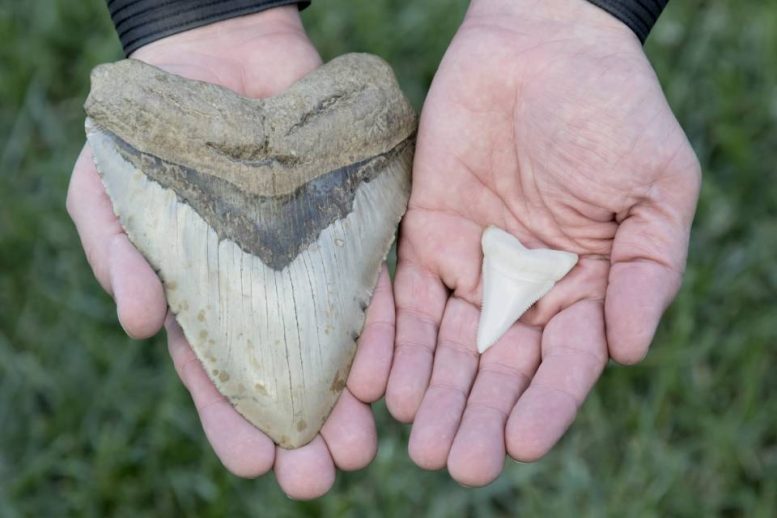
Megalodons are known only from the teeth they left behind. Here, a megalodon tooth (left) is compared to a great white shark tooth. Each inch of tooth corresponds to about 10 feet of length: 20 feet for the 2-inch great white shark tooth and 60 feet for the 6-inch megalodon tooth. Encased in rock-hard enamel, teeth are more easily preserved than bones, let alone a shark’s cartilage skeleton. Shark teeth are one of the most abundant fossil types because sharks have existed for more than 400 million years, and the predators are constantly growing and losing teeth, so every shark produces thousands of teeth over its lifetime. Credit: iStock.co
Megatooth sharks, the largest sharks that have ever existed, were also the greatest apex predators ever measured, according to a new Princeton study
According to a new Princeton study, ancient megatooth sharks – the largest sharks ever known — were apex predators at the greatest level ever recorded.

Emma Kast, a Ph.D. graduate of Princeton who is now at the University of Cambridge, is the first author of a new paper in the journal Science Advances. The paper began as a chapter in her 2019 dissertation. Credit: Sameer A. Khan/Fotobuddy
Megatooth sharks are named for their enormous teeth, some of which can be as large as a human hand. The group comprises numerous closely related species as well as Megalodon, the biggest shark to have ever lived.
While sharks of various types have lived for more than 400 million years, long before the dinosaurs went extinct, these megatooth sharks emerged after the dinosaurs died out and controlled the waters until about 3 million years ago.
“We’re used to thinking of the largest species — blue whales, whale sharks, even elephants, and diplodocuses — as filter feeders or herbivores, not predators,” said Emma Kast, a 2019 Ph.D. graduate in geosciences who is the first author of a new study recently published in the journal Science Advances. “But Megalodon and the other megatooth sharks were genuinely enormous carnivores that ate other predators, and Meg went extinct only a few million years ago.”
Her adviser Danny Sigman, Princeton’s Dusenbury Professor of Geological and Geophysical Sciences, added, “If Megalodon existed in the modern ocean, it would thoroughly change humans’ interaction with the marine environment.”
Megalodon and some of its predecessors were at the very top of the prehistoric food chain, or what scientists refer to as the greatest “trophic level,” according to new evidence from a team of Princeton researchers. The researchers claim that because of their high trophic signature, they must have consumed other predators and predators of predators in a complex food web.
“Ocean food webs do tend to be longer than the grass-deer-wolf food chain of land animals because you start with such small organisms,” said Kast, now at the University of Cambridge, who wrote the first iteration of this research as a chapter in her dissertation. “To reach the trophic levels we’re measuring in these megatooth sharks, we don’t just need to add one trophic level — one apex predator on top of the marine food chain — we need to add several onto the top of the modern marine food web.”
Megalodon has been conservatively estimated at 15 meters long — 50 feet — while modern great white sharks typically top out around five meters (15 feet).
By measuring the nitrogen isotopes in the sharks’ teeth, Kast, Sigman, and their colleagues were able to draw conclusions about the ancient marine food web. Ecologists have long known that an organism’s trophic level increases with the amount of nitrogen-15 it contains, but researchers have never been able to detect the minute quantities of nitrogen that have been stored in the enamel layer of these prehistoric predators’ teeth.
“We have a series of shark teeth from different time periods, and we were able to trace their trophic level versus their size,” said Zixuan (Crystal) Rao, a graduate student in Sigman’s research group and a co-author of the current paper.
One way to tuck in an extra trophic level or two is cannibalism and several lines of evidence point to that in both megatooth sharks and other prehistoric marine predators.
The nitrogen time machine
Without a time machine, there’s no easy way to recreate the food webs of extinct creatures; very few bones have survived with teeth marks that say, “I was chewed on by a massive shark.”

Professor Danny Sigman has spent decades developing more and more refined techniques for extracting and measuring the nitrogen isotope ratios from trace fossils, which reveal whether the organism was at the top, middle, or bottom of the food chain. Now, with a little help from dentists’ drills and some specially bred microbes, his team has determined that Megalodon and its fellow megatooth sharks were apex predators at the highest trophic (food web) level ever measured. Credit: Laura Pedrick, Department of Geosciences
Fortunately, Sigman and his colleagues have spent decades creating alternative techniques based on the understanding that a creature’s cell levels of nitrogen isotopes indicate whether it is at the top, middle, or bottom of a food chain.
“The whole direction of my research team is to look for chemically fresh, but physically protected, organic matter — including nitrogen — in organisms from the distant geologic past,” said Sigman.
A few plants, algae, and other species at the bottom of the food web have mastered the knack of turning nitrogen from the air or water into nitrogen in their tissues. Organisms that eat them then incorporate that nitrogen into their bodies, and critically, they preferentially excrete (sometimes via urine) more of nitrogen’s lighter isotope, N-14, than its heavier cousin, N-15.
In other words, N-15 builds up, relative to N-14, as you climb up the food chain.
Other researchers have used this approach on creatures from the recent past — the most recent 10-15 thousand years — but there hasn’t been enough nitrogen left in older animals to measure, until now.
Why? Soft tissue like muscles and skin are hardly ever preserved. To complicate matters, sharks don’t have bones — their skeletons are made of cartilage.
But sharks do have one golden ticket into the fossil record: teeth. Teeth are more easily preserved than bones because they are encased in enamel, a rock-hard material that is virtually immune to most decomposing bacteria.
“Teeth are designed to be chemically and physically resistant so they can survive in the very chemically reactive environment of the mouth and break apart food that can have hard parts,” Sigman explained. And in addition, sharks aren’t limited to the 30 or so pearly whites that humans have. They are constantly growing and losing teeth — modern sand sharks lose a tooth every day of their decades-long lives, on average — which means that every shark produces thousands of teeth over its lifetime.
“When you look in the geologic record, one of the most abundant fossil types are shark teeth,” said Sigman. “And within the teeth, there is a tiny amount of organic matter that was used to build the enamel of the teeth — and is now trapped within that enamel.”
Since shark teeth are so abundant and are preserved so well, the nitrogen signatures in enamel provide a way to measure status in the food web, whether the tooth fell from a shark’s mouth millions of years ago or yesterday.
Even the largest tooth has only a thin casing of enamel, of which the nitrogen component is only a tiny trace. But Sigman’s team has been developing more and more refined techniques for extracting and measuring these nitrogen isotope ratios, and with a little help from dentist drills, cleaning chemicals, and microbes that ultimately convert the nitrogen from within the enamel into nitrous oxide, they’re now able to precisely measure the N15-N14 ratio in these ancient teeth.
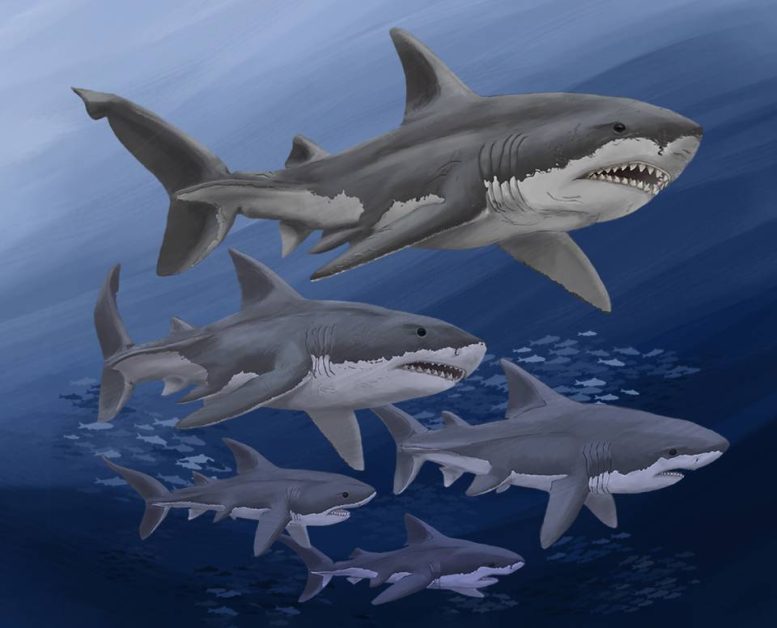
The megatooth sharks (genus Otodus) got larger over time. At the bottom is their ancestor Cretalamna, who lived about 50 million years ago and was comparable in size to a modern great white shark. From the bottom: Cretalamna (3.5 meters long), O. obliquus (8 m), O. auriculatus (9.5 m), O. angustidens (11.5 m), O. chubutensis (13.5 m), O. megalodon (15 m). Credit: Christina Spence Morgan
“We’re a little bit like a brewery,” he said. “We grow microbes and feed our samples to them. They produce nitrous oxide for us, and then we analyze the nitrous oxide they produced.”
The analysis requires a custom-built, automated nitrous oxide preparation system that extracts, purifies, concentrates, and delivers the gas to a specialized stable isotope ratio mass spectrometer.
“This has been a multiple-decades-long quest that I’ve been on, to develop a core method to measure these trace amounts of nitrogen,” Sigman said. From microfossils in sediments, they moved on to other types of fossils, like corals, fish ear bones, and shark teeth. “Next, we and our collaborators are applying this to mammalian teeth and dinosaur teeth.”
A deep dive into the literature during lockdown
Early in the pandemic, while her friends were making sourdough starters and bingeing Netflix, Kast pored through the ecologic literature to look for nitrogen isotope measurements of modern marine animals.
“One of the cool things that Emma did was really dig into the literature — all the data that’s been published over decades — and relate that to the fossil record,” said Michael (Mick) Griffiths, a paleoclimatologist and geochemist at William Patterson University and a co-author on the paper.
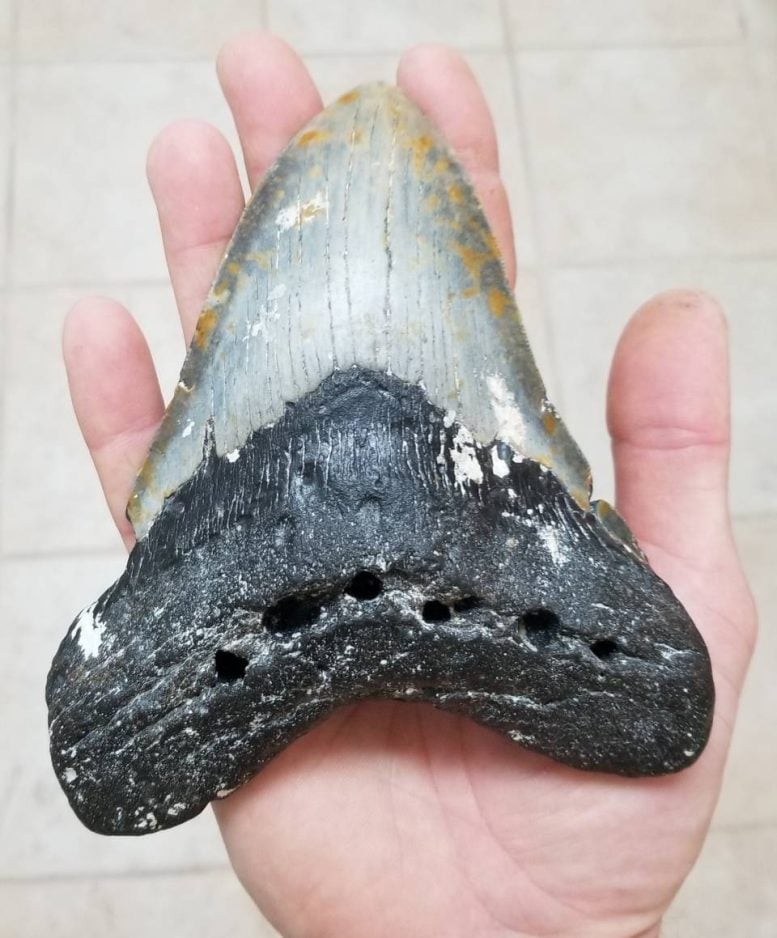
Harry Maisch of Florida Gulf Coast University, whose hand is holding this Megalodon tooth, gathered many of the samples used in this analysis and is a co-author of the new paper. Credit: Harry Maisch
As Kast was quarantined at home, she painstakingly built up a record with more than 20,000 marine mammal individuals and more than 5,000 sharks. She wants to take things much further. “Our tool has the potential to decode ancient food webs; what we need now is samples,” said Kast. “I’d love to find a museum or other archive with a snapshot of an ecosystem — a collection of different kinds of fossils from one time and place, from forams near the very base of the food web to otoliths — inner ear bones — from different kinds of fish, to teeth from marine mammals, plus shark teeth. We could do the same nitrogen isotope analysis and put together the whole story of an ancient ecosystem.”
In addition to the literature search, their database includes their own samples of shark teeth. Co-author Kenshu Shimada of DePaul University connected with aquariums and museums, while co-authors Martin Becker of William Patterson University and Harry Maisch of Florida Gulf Coast University gathered megatooth specimens on the sea floor.
“It’s really dangerous; Harry’s a dive master, and you really need to be an expert to get these,” said Griffiths. “You can find little shark teeth on the beach, but to get the best-preserved samples, you need to go down to the bottom of the ocean. Marty and Harry have collected teeth from all over the place.”
He added: “It’s been a really collaborative effort to obtain the samples to pull this together. In general, collaborating with Princeton and other regional universities is really exciting because the students are amazing and my colleagues there have been really great to work with.”
Alliya Akhtar, a 2021 Ph.D. graduate from Princeton, is now a postdoctoral researcher in Griffiths’ lab.
“The work I did for my dissertation (looking at isotopic composition of seawater) posed as many questions as it answered, and I was incredibly grateful to have the opportunity to continue working on some of these with a collaborator/mentor I respect,” Akhtar wrote in an email. “I’m most excited about all the work that is still to be done, all the mysteries yet to be solved!”
The study was funded by the Scott Fund of the Department of Geosciences, Princeton University, by grants from the National Science Foundation Sedimentary Geology and Paleobiology (1830581 to M.L.G. and M.A.B.; 1830638 to R.A.E.; 1830480 to S.L.K.; and 1830858 to K.S.), the European Research Council Consolidator Grant Agreement 681450 (to J.N.L., awarded to T. Tütken), the Max Planck Society (to A.M-G. and G.H.H.), and the American Chemical Society Award, Petroleum Research Fund Undergraduate New Investigator Grant, PRF #54852-UNI2 (to M.L.G.).
Reference: “Cenozoic megatooth sharks occupied extremely high trophic positions” by Emma R. Kast, Michael L. Griffiths, Sora L. Kim, Zixuan C. Rao, Kenshu Shimada, Martin A. Becker, Harry M. Maisch, Robert A. Eagle, Chelesia A. Clarke, Allison N. Neumann, Molly E. Karnes, Tina Lüdecke, Jennifer N. Leichliter, Alfredo Martínez-García, Alliya A. Akhtar, Xingchen T. Wang, Gerald H. Haug and Daniel M. Sigman, 22 June 2022, Science Advances.
DOI: 10.1126/sciadv.abl6529

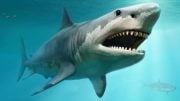

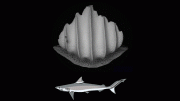


Be the first to comment on "New Evidence Reveals That Megalodons Were Even More Terrifying and Powerful Than Scientists Thought"